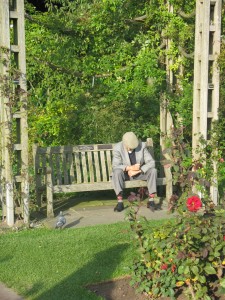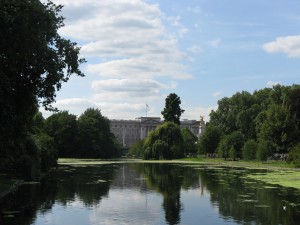I used to think that William Wordsworth was kind of a sap, always going on about daisies in a field and all that in his poetry, but since arriving in London, I’ve come to respect his stance a lot more. I still think that Wordsworth is a bit melodramatic, but I understand his need to remember images from nature. I grew up in rural Connecticut, so I’m used to seeing cows, fields, and woods all on my two-minute drive to the center of town. Before this program, I had not spent more than three consecutive days in a city, and I can honestly say that the parks have kept me sane. London is a wonderfully dynamic city, but it’s also exhausting, and I think that the parks here are an absolute necessity for the people who live here.
London, like any major city, is loud, chaotic, fast-paced, and extremely crowded. Walking down Tottenham Court Road is an exercise in agility. Weaving through people all of the time, especially tourists who stop short to take photographs or consult maps, can become extremely frustrating. But inside of the parks, the bustle of the city seems much farther away. In Queen Mary’s Garden at Regent’s Park today, I was almost able to forget that Marylebone Road ran just outside of the gates. It’s quiet, and you can actually hear the sounds of nature. Although some parks undeniably attract more tourists than others, I saw people just laying on the grass sleeping, reading, doing absolutely nothing at all, in all of the parks that I visited. I think that people are just so relieved to be out of the insanity that is London’s streets that they can’t resist the opportunity to sit down and enjoy a quiet moment.
This is reflected in the development of the parks, as well. Regent’s Park and St. James Park were both made into hunting grounds by King Henry VIII, but they’ve become beautiful, public green spaces. Hyde Park and Kensington Gardens really were formed due to necessity; Queen Victoria decided that the public could really use a park to combat the crowded, polluted conditions of a newly industrialized London in the nineteenth century. Wordsworth fell at the beginning of this time–in his day, London was just beginning to become an industrial power, and we can be fairly certain that his description of the city in his poem “Composed Upon Westminster Bridge” were not completely accurate. Wordsworth sought out beauty in nature because he was suffocated by conditions in the city.
Yes, some of the gardens seem a bit contrived (the bridge at St. James Park just happens to offer beautiful, leafy views of both Buckingham Palace and Whitehall), but the English do love gardening. And today in Regent’s Park I saw people ambling slowly through the very well-manicured rose gardens, literally stopping to smell the flowers. Couples were cozied up on benches, people were reading under weeping willow trees, and one gentleman was just conked out in the sun. As I walked down the avenue, I noticed people sunbathing and playing a football match, also a common sight in Hyde Park and Kensington Gardens. No one, regardless of whether or not they were tourists, was in a hurry, and that’s exactly why the parks here in London are so important. People just need an escape from the city for a bit.



1 response so far ↓
Karl // Sep 21st 2010 at 10:30
There could be no more truth than your last sentence!
You must log in to post a comment.